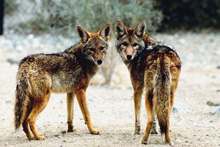Coyote Attacks on the Rise in the U.S. …
What to Do and NOT Do if You See a Coyote!
by www.SixWise.com
Coyotes normally avoid contact with humans, but recently it seems some coyotes are becoming “urbanized” -- making sightings, and in some cases attacks, much more common.
|

Once exclusive to the western Plains, coyotes now live in every U.S. state except Hawaii.
|
Some blame suburban sprawl, others the decline of coyotes’ main competitor the wolf, while others say increasing numbers of coyotes and people are causing coyotes to come out of the wilderness. But wildlife officials point out that coyotes have always been part of the United States and now they’re simply adapting to more urban landscapes.
Originally coyotes lived exclusively in the western Plains states. Today they reside in every U.S. state except for Hawaii, and sprawl from Alaska to Central America. Coyotes in their native, wilderness habitat pose little risk to humans. However, when they begin to populate suburban and urban areas, as is happening now, more coyote-human encounters occur, and that’s when problems can develop.
In Denver, Colorado, for instance, four people have been nipped or bitten by coyotes since December. Even in New York and Chicago coyote sightings aren’t unheard of. New York State is home to between 20,000 and 30,000 coyotes alone.
And in Chicago, Stan Gehrt, an assistant professor at Ohio State University's School of Environment and Natural Resources, has radio-collared and tracked 300 coyotes, one of which likes to hide out near the downtown’s famous post office, where thousands of people pass within yards of it each day.
Are Coyotes Becoming More Aggressive?
Wildlife officials seem to disagree on whether or not coyotes are losing their fear of humans.
"They are scavengers as well as hunters, and they are very smart," California Department of Fish and Game spokesperson Lorna Bernard said in National Geographic. "When they learn that people aren't a danger to them, they become very brazen."
Still, Stan Gerht says, "Even though they live in urban areas and figure out how people work ... it doesn't mean they're necessarily becoming more aggressive toward us.”
|

Coyotes typically prefer to avoid humans, but if you do see one wildlife experts say yelling and throwing rocks will help to keep it that way.
|
He points out that even coyotes living in urban areas, where you might expect them to eat a lot of garbage or pets, still eat rodents most often, followed by deer, rabbit and birds.
Further, while there have been cases of coyotes coming into fenced yards and killing a dog or cat, or even taking a pet from a child’s arms or off a leash, there has been only one documented fatal coyote attack in the United States, which occurred when a toddler was killed in California in 1980.
“We've had quite a few attacks," Bernard said, "but people don't typically get seriously hurt."
What Should You do if You See a Coyote?
"Ninety-five percent of this problem is a human problem, and we really need to focus on that 95 percent to solve it," Nicole Rosmarino, wildlife program director of the environmental group WildEarth Guardians, told the Associated Press.
In other words, your actions can either help or hinder our ability to co-exist with these wild creatures. Nowadays, no matter where you live in the United States, there’s a chance you may encounter a coyote. If you do, wildlife officials recommend:
- Do not feed coyotes.
- Keep pets on a short leash.
- Yell or throw rocks to scare it away.
- Don’t leave pet food and garbage outdoors.
- Don’t leave pets alone outside.
Further, if you live in an area where coyotes are known to frequent, you can best co-exist by:
- Not feeding birds. The birdseed will attract rabbits, squirrels, mice and other small animals that coyotes like to prey on.
- Picking fruit on outdoor trees (and keeping it off the ground). Grapes, berries, avocados and other soft fruits can attract coyotes.
- Surrounding your property with a tall fence. It’s rare for a coyote to climb anything higher than a six-foot fence. You can also place large rocks or cement blocks outside of your fence to prevent animals from digging into your yard.
- Spaying or neutering your pet, as unfixed pets can attract coyotes during mating season.
- Placing battery-operated flashing lights, tape-recorded human noises, scattered moth balls and ammonia-soaked rags at key points on your property to help deter coyotes.
"Don't feed them, either purposely or inadvertently, and stay away from animals that show no natural fear," wildlife biologist Gordon Batcheller said in National Geographic. "Like other wildlife, coyotes should be enjoyed and appreciated, but from a distance. It does this species no good to encourage abnormal behaviors."
Use the SixWise.com Email to a Friend feature (in the upper right corner of this page) to share this article with your friends and loved ones!
Recommended Reading
Wildlife Services Kills 1.7 Million Animals Yearly
The Dangers of Typical Neighborhood Animals You Don't Think of as Dangerous (Squirrels & Raccoons & Skunks, Oh My!)
Sources
Yahoo News March 29, 2009
FoxNews.com May 12, 2008
NationalGeographic.com June 7, 2005
FundWildlife.org Co-existing With Urban Wildlife